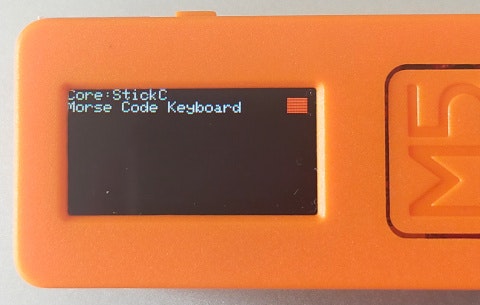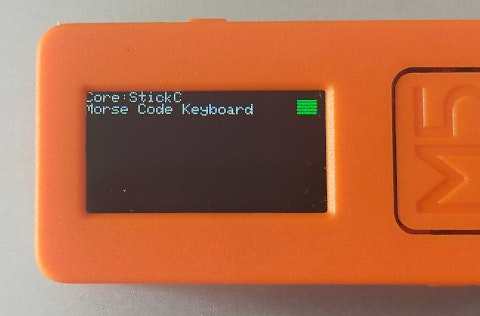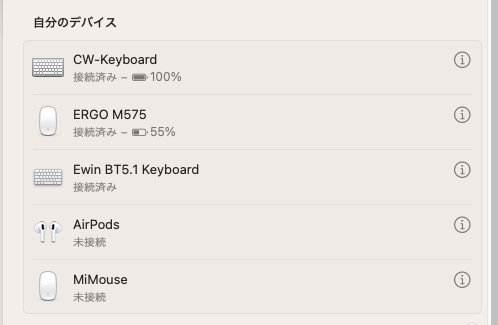この記事はM5Stack Advent Calendar 2022の17日目の記事です。
作ろうと思ったきっかけ
もともとはMONOISTの「モールス信号キーボード」の記事を読んで、「M5StickCだとボタンも大きいしハード追加もしで作れるし、モールス符号の勉強もできそう」と思ったのがきっかけです。(ちなみに筆者は電信級は持っていません)
これ、#M5StickC で無線キーボード化してみようかと。https://t.co/EEeEwYXQFY
— tomorrow56@モモモフ済 (@tomorrow56) December 6, 2022
作ったもの
BLEキーボードとして機能する1キーのモールス符号デコーダー(CW Decode Keyboard)です。
Bluetoothの接続状態は画面右上のマークで表示しています。ホストと接続する前は、マークが赤くなります。
ホストと接続すると、マークが緑になります。
ホスト(PC)からは"CW-Keyboard"という名前のBluetoothキーボードとして認識されます。
サンプルコード
作成したコード(Arduino IDE用スケッチ)はgithubにアップしています。
https://github.com/tomorrow56/CW_BLEKeyboard
スケッチはM5StickCを使って動作させていますが、M5Unifiedライブラリを使用していますので、入力ピンの設定を変更すれば他のM5Stackシリーズでも動作するはずです。
コードの説明
モールス信号をデコードする部分の基本のアルゴリズムは MONOISTの記事に掲載されていたコード を使わせていただきました。
プログラムの見通しを良くするためパラメータの変数化と一部コードの修正を行っています。
BLEキーボードのインスタンス
M5Stack(ESP32)用のBluetoothライブラリは"NimBLE"を使用します。
インスタンスするときの引数で"deviceName","deviceManufacturer","batteryLevel"を設定します。
// for BLE Keyboard
#include <BleKeyboard.h>
BleKeyboard bleKeyboard("CW-Keyboard", "M5Stack", 100);
モールス信号デコード用の各種パラメータの設定
M5StickCのボタンが押された長さから短点(・)と長点(-)の判定をするための各種パラメータです。
inputPinはM5StickCの液晶と同じ面にあるボタンA(G37)を指定しています。
// for Morse Decode
unsigned long signal_len,t1,t2,t0; //time for which button is pressed
String code = ""; //string in which one alphabet is stored
const int spacePeriod = 2000; //Waiting period until a space is entered
const int debouncingPeriod = 20; //switch debouncing
const int longpressLimit = 500; //Limit of long Press time
boolean connectDotDash = true; //Code connect flag
int inputPin = G37; //M5StickC BtnA for input
setup関数
setup関数の最初に各種設定を行います。ボードタイプの判別は関数化(boardType())しています。
void setup(void)
{
auto cfg = M5.config();
#if defined ( ARDUINO )
cfg.serial_baudrate = 115200; // default=115200. if "Serial" is not needed, set it to 0.
#endif
cfg.clear_display = true; // default=true. clear the screen when begin.
cfg.output_power = false; // default=true. use external port 5V output.
cfg.internal_imu = false; // default=true. use internal IMU.
cfg.internal_rtc = false; // default=true. use internal RTC.
cfg.internal_spk = false; // default=true. use internal speaker.
cfg.internal_mic = false; // default=true. use internal microphone.
M5.begin(cfg);
M5.Display.setBrightness(64);
if (M5.Display.width() < M5.Display.height())
{ /// Landscape mode.
M5.Display.setRotation(M5.Display.getRotation() ^ 1);
}
int textsize = M5.Display.height() / 160;
if (textsize == 0)
{
textsize = 1;
}
M5.Display.setTextSize(textsize);
// hardware model check
char* boardName = boardType();
M5.Display.startWrite();
M5.Display.print("Core:");
M5.Display.println(boardName);
ESP_LOGI("setup", "core:%s", boardName);
M5.Display.println("Morse Code Keyboard");
inputPinをプルアップ入力に設定し、BLEキーボードを開始します。
// Key setting internal pullup
pinMode(inputPin, INPUT_PULLUP);
// start BLE Keyboard
Serial.println("Starting BLE work!");
bleKeyboard.begin();
}
loop関数
入力したモールスコードをデコードして画面に表示する位置とサイズを指定します。
void loop(void)
{
vTaskDelay(1);
int h = M5.Display.height() / 8;
int w = M5.Display.width() / 12;
// M5.update();
M5.Display.setCursor(w*5, h*3);
M5.Display.setTextSize(3);
ホストに接続されたら入力判別処理に入り、マークを緑にしてボタンが押されるのを待ちます。ボタンが押されたことを検出したら、t1に現在の時間を代入します。押されていなかった期間が"spacePeriod"より長い場合はスペースを入力します。
if(bleKeyboard.isConnected())
{
M5.Display.fillRect(w*11, h/2, w, h, TFT_GREEN);
while (connectDotDash == true)
{
t0 = millis();
// waiting for button press
while (digitalRead(inputPin) == HIGH)
{
}
// Enter a space if no key is pressed for a certain period of time
if (millis()-t0 > spacePeriod)
{
bleKeyboard.print(' ');
Serial.print(' ');
}
t1 = millis(); //time at button press
次にボタンが離されるのを待ちます。ボタンが離されたら押されていた期間を"signal_len"に代入し、チャタリング防止期間(debouncingPeriod)より長い場合は、readio()関数を呼び出して、押された期間によって短点・長点を判定して"code"変数に追加します。
"longpressLimit"の期間でループを回し、この間にキーが押されたら、入力判別処理のループを繰り返します。
キーが押されなかったら、文字区切りと判断しループを抜けます。
// waiting for button released
while (digitalRead(inputPin) == LOW)
{
}
t2 = millis(); //time at button release
signal_len = t2 - t1; //time for which button is pressed
if (signal_len > debouncingPeriod) //to account for switch debouncing
{
code += readio(); //function to read dot or dash
}
//limit of long press
//if time between button press greater than 0.5sec, skip loop and go to next alphabet
while ((millis() - t2) < longpressLimit)
{
if (digitalRead(inputPin) == LOW)
{
connectDotDash = true;
break;
}else
{
connectDotDash = false;
}
}
}
入力判別処理のループを抜けたら"convertor()"関数で"code"変数をデコードし、結果を"keyin"変数に代入し、LCD表示とホストへの送信を行います。
char keyin = convertor(); //function to decipher code into alphabet
Serial.print(keyin);
M5.Display.print(keyin);
bleKeyboard.print(keyin);
connectDotDash = true;
}
else
{
M5.Display.fillRect(w*11, h/2, w, h, TFT_RED);
}
}
boardType()関数
M5Unifiedのボードタイプの判別部分を切り出した関数です。戻り値はボードタイプです。
/**********
* hardware model check
**********/
char* boardType()
{
char* name;
switch (M5.getBoard())
{
#if defined (CONFIG_IDF_TARGET_ESP32C3)
case m5::board_t::board_M5StampC3:
name = "StampC3";
break;
case m5::board_t::board_M5StampC3U:
name = "StampC3U";
break;
#else
case m5::board_t::board_M5Stack:
name = "Stack";
break;
case m5::board_t::board_M5StackCore2:
name = "StackCore2";
break;
case m5::board_t::board_M5StickC:
name = "StickC";
break;
case m5::board_t::board_M5StickCPlus:
name = "StickCPlus";
break;
case m5::board_t::board_M5StackCoreInk:
name = "CoreInk";
break;
case m5::board_t::board_M5Paper:
name = "Paper";
break;
case m5::board_t::board_M5Tough:
name = "Tough";
break;
case m5::board_t::board_M5Station:
name = "Station";
break;
case m5::board_t::board_M5Atom:
name = "ATOM";
break;
case m5::board_t::board_M5AtomPsram:
name = "ATOM PSRAM";
break;
case m5::board_t::board_M5AtomU:
name = "ATOM U";
break;
case m5::board_t::board_M5TimerCam:
name = "TimerCamera";
break;
case m5::board_t::board_M5StampPico:
name = "StampPico";
break;
#endif
default:
name = "Who am I ?";
break;
}
return name;
}
char readio()関数
短点・長点を判定する関数です。MONOISTに掲載のコードをそのまま使わせてもらっています。
char readio()
{
if (signal_len < 200 && signal_len > 20)
{
return '.'; //if button press less than 0.2sec, it is a dot
}
else //if (signal_len >= 300)
{
return '-'; //if button press more than 0.2sec, it is a dash
}
}
convertor()関数
モールス符号を英数字・記号に変換する関数です。MONOISTに掲載のコード(基本の英数字)をベースに英文モールス符号で規定されている記号を一通り追加しました。ただし、“ダイアクリティカルマーク”付きアルファベットは対応していません。
ここで定義されていないモールス符号が入力された場合は、ホストに改行コードを送信します。
char convertor()
{
static String letters[] = {
".-", // A (1)
"-...", // B
"-.-.", // C
"-..", // D
".", // E
"..-.", // F
"--.", // G
"....", // H
"..", // I
".---", // J
"-.-", // K
".-..", // L
"--", // M
"-.", // N
"---", // O
".--.", // P
"--.-", // Q
".-.", // R
"...", // S
"-", // T
"..-", // U
"...-", // V
".--", // W
"-..-", // X
"-.--", // Y
"--..", // Z (26)
"-----", // 0
".----", // 1
"..---", // 2
"...--", // 3
"....-", // 4
".....", // 5
"-....", // 6
"--...", // 7
"---..", // 8
"----.", // 9 (36)
"E" // end code
};
int i = 0;
char c;
if (code == ".-.-.-")
{
c = '.'; //period
}
else if (code == "--..--")
{
c = ','; //comma
}
else if (code == "..--..")
{
c = '?'; //question
}
else if (code == ".----.")
{
c = 0x27; //Apostrophe (')
}
else if (code == "-.-.--")
{
c = '!'; //Exclamation
}
else if (code == "-..-.")
{
c = '/'; //slash
}
else if (code == "-.--.")
{
c = '('; //Open parenthesis
}
else if (code == "-.--.-")
{
c = ')'; //Close parenthesis
}
else if (code == ".-...")
{
c = '&'; //ampersand
}
else if (code == "---...")
{
c = ':'; //colon
}
else if (code == "-.-.-.")
{
c = ';'; //semicolon ';'
}
else if (code == "-...-")
{
c = '='; //double dash
}
else if (code == ".-.-.")
{
c = '+'; //plus
}
else if (code == "-....-")
{
c = '-'; //hyphen
}
else if (code == "..--.-")
{
c = '_'; //underscore
}
else if (code == ".-..-.")
{
c = '?'; //Question
}
else if (code == "...-..-")
{
c = '$'; //Dollar
}
else if (code == ".--.-.")
{
c = '@'; //at mark
}
else if (code == "...-.-")
{
c = 0x0a; //end of work, send "LF"
}
else
{
while (letters[i] != "E") //loop for comparing input code with letters array
{
if (letters[i] == code)
{
if (i>25)
c = '0'+(i-26);
else
c = 'A'+i;
break;
}
i++;
}
if (letters[i] == "E")
{
c = 0x0a; //if input code doesn't match any letter, send "LF"
// Serial.println(""); //if input code doesn't match any letter, error
}
}
code = ""; //reset code to blank string
return c;
}
参考にしたサイト
以下のサイトの情報を参考にさせていただきました。どうもありがとうございます。
M5Unified
CW Decorder
Morse Code
NimBLE Keyboard


